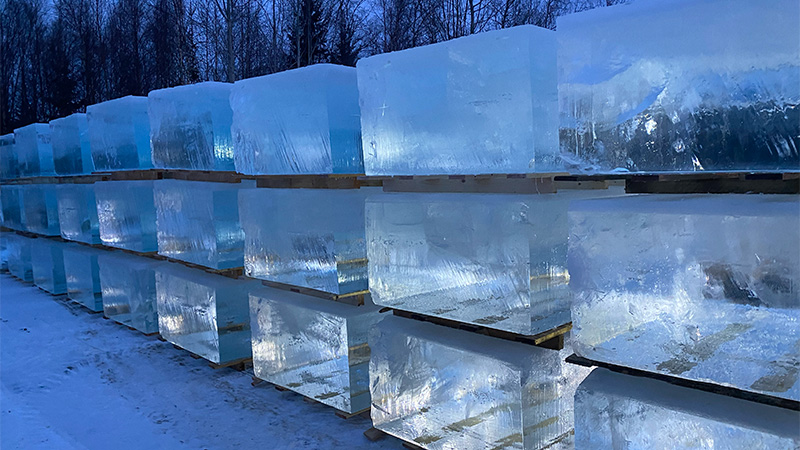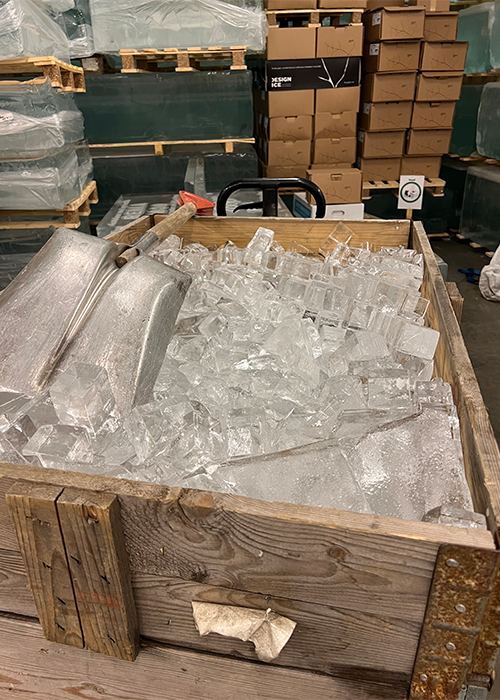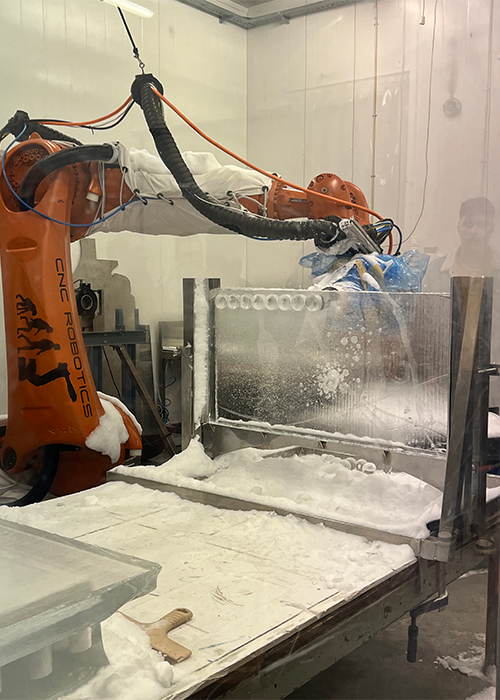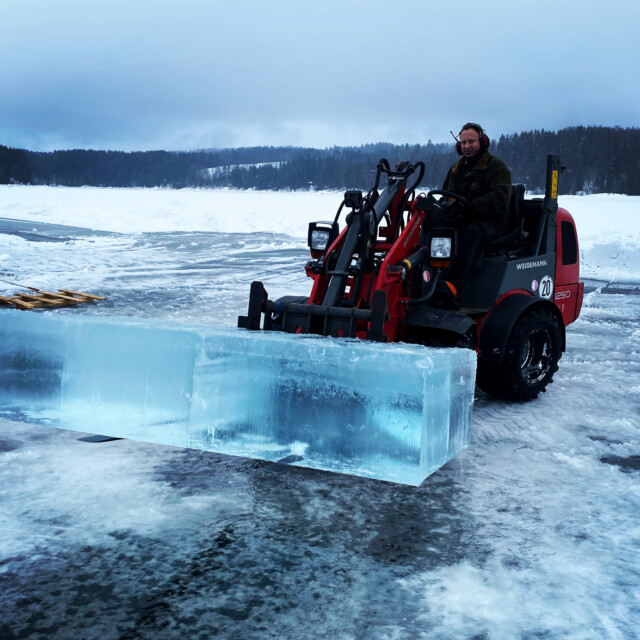Frosty, cooling drinks like juleps and cobblers were trending in early 1800s America, their popularity driven by the recent year-round availability of ice. Blocks of it were cut from ponds and lakes in Massachusetts and Maine in the winters, then sold locally or exported abroad on ships specially insulated to keep as much of it solid as possible.
When the cold cocktail trend caught on in the United Kingdom, thanks in part to books like Charlie Paul’s “Recipes of American and other Iced Drinks,” London ice delivery men wore uniforms with eagle buttons to reinforce the product’s U.S. provenance. Initially, ice was a luxury product over there, and the Wenham Lake Ice Company (located just north of Salem, Mass.) was the leading provider in London, at least until counterfeit cubes flooded the market.
In 1873, The Food Journal reported that “the use of ice has gradually increased among our population in the last twenty years, at an ever-accelerating rate, although it is as yet by no means as necessary an article in our domestic economy as among our American cousins,” and also that most of the U.K.’s ice now came from Norway. The country had a long-established relationship selling ice (usually along with fish) to the U.K. and wanted in on the cool new action. In fact, one Norwegian company renamed one of its local lakes from Lake Oppegård to Wenham Lake so that it could sell its ice under the same name as the famous American company.
The Norwegian lake ice export business lasted several decades, until more efficient machine-created ice became an affordable option in London, at which point there was no reason to import it from more northerly climes.
Now, another hundred years after that, one man outside of Oslo is trying to bring back cocktail ice that he harvests from a lake. Yet, if he’s going to find success — and break into the larger international cocktail scene — he’ll have to prove that the giant blocks of lake ice are both safe to drink, and efficient to send abroad.
Welcome to the Farm
Typically, the year’s harvest is conducted over two days in the middle of each February, but Thomas Orderud of DesignIce says there may not be one this year. The ice on Hemnes Lake was looking thin before the new year, then it snowed and later rained. This doesn’t make for ice that’s thick enough to support machinery nor clear enough to sell, but that’s the nature of the business when your business is nature. Luckily, Orderud has 450 tons of ice harvested in previous years stored back on his “ice farm.”
Orderud’s operation is located about an hour’s drive from Oslo in Østfold County, a screensaver-perfect agricultural area replete with rolling hills, red-painted barns, and super-clean lakes. The property has been in Orderud’s family since the 1920s.
His barn is a temperature-controlled building tightly stacked about 16 rows deep and up to seven high with palates holding gargantuan one-ton ice blocks; it looks a bit like the end of the first Indiana Jones movie.
Most of the ice comes from Hemnes Lake, a couple more minutes’ drive from the farm, though Orederud has backup lakes scouted just in case. To harvest it, Orderud says the ice should be at least a foot thick (which it may not reach this year). He and his small team — usually four people in total — clear any snow off a big rectangle of the surface with a snowblower. They then cut a long, meter-wide strip down the lake using a tractor rigged up with an arm that drags two chainsaws spaced apart. Another crew member cuts that strip into two-meter segments with a handheld chainsaw, after which the blocks are dragged along the channel to shore where they’re carried with a forklift onto palates and then loaded onto a truck.

Orederud’s team can harvest about 100 one-ton blocks over a full day. How much they take each year depends more on the quality of the ice than how much space there is in the barn (lesser-quality existing blocks can always be taken outside to melt and return to nature if need be).
The Strong Arm of the Thaw
Nearly all craft cocktail ice providers that produce large, two-inch clear cubes to sell to bars do so by first making a 300-pound ice sculpture block usually called a Clinebell block, named after the brand of the most popular block machine manufacturer. Then they cut that block into slabs, and further into cubes with a band saw.
Larger ice companies that produce wedding and corporate event ice sculptures with precision carved logos usually employ a computer numerical control (CNC) machine, which is a drill bit that moves over the surface of a block to cut designs into it. In the ice barn at DesignIce, however, the company has a giant (and surely incredibly expensive) six-axis robotic arm that can cut entire three-dimensional sculptures up to six feet tall and wide.
Also an option: ice for drinks. In fact, this might be the only example of one of these robots used exclusively for ice in the world. Most others are used outside of freezers in the aerospace, automotive, medical, and other industries for precision 3D cutting, machining, and other tasks.

Perhaps that seems like overkill, when most companies use smaller/cheaper equipment and just hire human ice carvers for larger projects. “Yeah, it is. Absolutely. But it’s fun,” Orderud says. It’s also easier to find people to program the robotic arm than to hand-carve ice sculptures these days, he says, and after you’ve taught the robot the sculpture once you can repeat it at the touch of a button.
Nature, Can You Trust It?
Every few years, an “entrepreneur” gets the “original” idea to forage small icebergs for ice cubes. The pushback is generally instantaneous and loud — see: Martha Stewart drinking an iceberg on a cruise, and ice from Greenland going “to chill posh drinks in Dubai.” The icebergs are free-floating and going to melt into the ocean regardless, so the hysteria is unwarranted.
The ice is safe to drink, but is it better for the environment than machine ice when you ship it long distances?
The reason for harvesting icebergs is that this ice, formed from layers of snow packing down over centuries on glaciers, is older than industrial processes, and therefore pure. Orderud had considered collaborating with a company harvesting glacier ice around 2016, but ruled it out as it would be too hard to test for safety from biological contamination of ice. “You have no control of droppings from reindeer and everything a thousand years back in time,” he says.
Glacier ice is also very different in the glass from either lake or machine ice. On the minus side, it is not clear, as it’s made from snow. On the plus side, air compressed and trapped in the ice is released when it melts into a drink, making a soft crackling sound like Rice Krispies.
The clear, crackle-free ice from Hemnes Lake is tested at several points. Before harvest, Orderud does a visual inspection for any unexpected sources of contamination such as dead animals that may have fallen through ice. (A reindeer would be very unexpected, as a web search tells me you only find them in northern Norway.)
One of his employees then drives an ice sample to a lab about an hour away to have it tested for bacteria. After harvest, they collect samples from all the blocks to test again. Then every three months, they test the latest batch of cocktail ice to ensure that the cutting tools and processes haven’t contaminated it in handling. As far as Orderud has been able to find, he is the only person selling food-grade ice from lakes in the modern era.
Nature Versus the Machines
The ice is safe to drink, but is it better for the environment than machine ice when you ship it long distances? Orderud commissioned an energy study from the Norwegian Institute of Bioeconomy Research to find out, comparing the production of ice from a typical Clinebell machine located somewhere in Europe to his lake ice harvesting/storing/transport from Norway. This could help justify sending ice from Norway (where the energy mix comes largely from renewable sources like hydropower), all the way to places like London once again.
The report took into account the fuel the tractors use to haul ice from the lake and the tap water needed in Europe and electricity to freeze it, among other factors. It concluded that one could send the lake ice 286 miles by truck, 1,438 miles by rail, or 4,284 miles by container ship until it broke even with the energy required to produce a Clinebell block. By my estimation, not only would that get the lake ice to London, it could reach all the way to Charleston, S.C.

The study also included a more conservative estimate that would still see the ice arriving in Newfoundland before it tied with the machine-made ice, from an energy perspective — and this study was completed before Orderud installed solar panels on the ice barn’s roof. He hopes that new stricter legislation and incentives around sustainability in the European Union will make his lake ice a more attractive product, and now he has some data to back it up.
Inquiries have come from brokers in Spain and the U.K., but so far, the cubes, spears, and spheres from DesignIce are only available at bars in Oslo and a couple other Norwegian cities. “I hope that the businesses open their eyes more and more, and understand that it’s important to have good quality of ice with a good story,” Orderud says.
